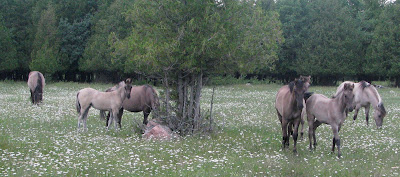
Here I am at the studio, on a very busy day during the height of tourist season, but after reading this morning a very moving entry in a blog called: Chloe, the Pony Who Wouldn't, I feel compelled to direct readers to this entry.
I'd also like to direct readers to an interview that appeared on the Nevzorov Haute Ecole website: Interview with Michael Bevilacqua by Cloé Lacroix and Kris McCormack
In this interview, Michael Bevilacqua sums up very clearly how an egalitarian partnership with a horse based on a friendship relationship is likely to be ill-appreciated by individuals who prefer to be with horses who are trained to accept a human as hierarchially dominant and submissive to our desires.
"The horses showed me a side of themselves that gradually changed my thinking more and more. It came to a point that I had to train the people, not the horses. Horses that I worked with at home would be so good with me. They would also be pretty good with the owner if I were present. If an owner showed up when I was not around, I would hear that they could sometimes not even halter the horse and would completely give up and leave in anger and frustration. What I realized after dropping one training tradition after another, was that my horses, or all the horses I trained, because no force and pain were involved, were not `broken`. It was a trust and a bond that we developed. This trust and bond, comprehension, and willingness were part of our unique relationship. That relationship was not transferable."--Michael Bevilacqua
There are those people who want to have friendly relations with horses, yet still want their horses to yield in all circumstances and respond in push-button manner to the directions of humans. Horses trained in this manner by and large will allow themselves to be used by any human.
And then there are those individuals who are interested in more than "friendly relations"--they want a two-way friendship with this fantastic being, the horse. Horses "trained" within this type of framework will not allow themselves to be passed around and used like a piece of sports equipment.
As Michael states, such a relationship is "not transferable".

You will read that June has found that nurturing a relationship with horses that allows for free expression from both the equine and the human establishes a much richer marriage between the species. However, during a visit from her friend, June learns that the type of relationship she has with her horses is "not transferable", nor is it understood or appreciated by those accustomed to horses that are trained to be subordinate.
The difference is that one approach is a "method" and the other is a "relationship"--a coming together between two beings who desire a friendship. Such friendships may not be understood or appreciated by traditional horse folk, but as June reminds us by quoting Imke Spilker, "Who inspects my work? Who supervises me? My horse."

June's blog entry does a fantastic job of processing the criticism of a knowledgeable horse friend--even understanding its reasoning, but in the end she knows for certain traditional training modalities no longer suit her and her horses, and why. I hope you will take the time to follow the link and read what she has written. It's an honest and profound testament to how difficult this journey can be at times when we realize "A Delicate Balance is Disturbed".





































